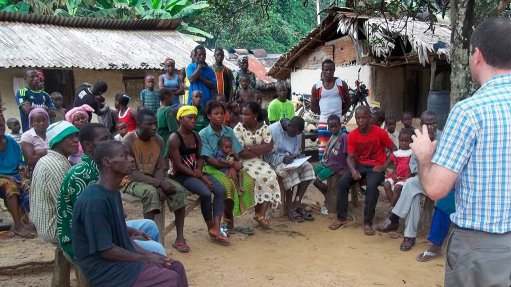
CONSULTATION Mining companies have to communicate the potential environmental impact of their operations to local communities
Proposed mining projects’ investment and capital expenditure decisions should be informed by an early understanding of social risks, says environmental and social services provider Digby Wells Environmental stakeholder engagement departmental manager Nestus Bredenhann.
He states that obtaining a social licence to operate (SLO) has for some time now been more prominent on the list of key business risks for mining companies and is a top priority for executives in the extractives industry.
“An SLO enables the organisation to gain deeper insight into how its behaviour is perceived by external parties.”
The mining industry uses tools that take social risks into account – such as the International Finance Corporation’s Financial Valuation Tool that assesses sustainability investments – to gauge the feasibility of proposed projects, Bredenhann explains.
Further, he tells Mining Weekly that to refine their organisational strategy and implement improved risk management, coal mining companies have to communicate the potential environmental footprint of their operations to local communities timeously and clearly.
Early Strategic Stakeholder Engagement (ESSE) is a process followed by the mining industry that is largely focused on the initial stages of the project life cycle to avoid conflicts, identify risks, manage stakeholder expectations and avoid project delays, Bredenhann adds.
However, he says the stakeholder engagement process does not end once the mine starts operating.
“The engagement process has to be implemented throughout the project life cycle in a way that will ensure a trusting and open dialogue between the mine and stakeholders for better decision-making.”
Many strategic choices made by the mining company might have an impact on future relations with stakeholders, albeit during the feasibility or operational phases of the proposed project, adds Bredenhann.
Challenging Environment
Bredenhann says the South African mining context can be complex, as it is, among other dynamics, characterised by engaging with communities as well as integrating the role of government into that stakeholder engagement process.
In this regard, it would be useful to incorporate ESSE principles into an organisation’s strategic planning to gain an early and deeper understanding of community and government perceptions, expectations and key issues, he notes.
This could make engagement more sustainable, since the process is initiated early to ensure that long-term partnerships are created, says Bredenhann, adding that the process will also allow for valuable stakeholder inputs to be considered in terms of corporate social investment initiatives, strategic decision-making and project planning.
He further tells Mining Weekly that the concept of ESSE correlates with recent amendments made to the National Environmental Management Act that was promulgated in December last year.
“The amendments impose more stringent timelines on environmental assessment practitioners to complete the public consultation and scoping report review process within a maximum period of 44 days within the scoping phase.”
Moreover, the environmental impact assessment (EIA) regulations require that a detailed site selection process be included in the scoping report that will be made available to the public for comment, says Bredenhann.
This means that detailed specialist information is required early in the consultation process – even before the mining right application is submitted to the Department of Mineral Resources, he says.
He adds that the site selection process, therefore, now requires specialists to conduct more detailed studies before the mining project is formally announced or before the scoping phase starts.
“These new amendments are necessary and welcome. Good practice would suggest that prescoping consultation be done to ensure that stakeholders are provided with sufficient opportunity to participate freely and meaningfully in the EIA process,” says Bredenhann.
He adds that the new regulations provide an opportunity to include ESSA as part of an informal process of engagement. However, once the mining right application has been submitted, a formal engagement procedure must be followed within the legislated timeframes.
“Stakeholders need to be allowed sufficient time to understand the complexities and anticipated impacts of the proposed project and, as a result, be empowered to provide input for the scope of work of the specialist studies to be undertaken,” he concludes.